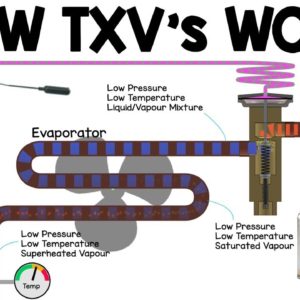Hey there, guys, Paul here
from TheEngineeringMindset.com. In this video, we are gonna be looking at how a thermostatic expansion valve works. We'll be covering which refrigerator
systems use these valves, where to locate them in the system, what the valves look like, what's inside them, how they work, and what happens if they fail. Now, I just want to say
a very special thanks to Danfoss for sponsoring this video.
Danfoss have so many
solutions for those of us that work in the air conditioning
and refrigeration space. If you're watching this
video, chances are very good that you need high-quality
thermostatic expansion valves on a regular basis. And you should definitely look
at what Danfoss has to offer. Their line of products are
universal and adaptable delivering exceptional
quality and reliability, as well as a wide capacity
in refrigerant range. You can find out more about the Danfoss
thermostatic expansion valves in the video description below, or by visiting TXV or Danfoss.com.
The thermostatic expansion
valve is often shortened and called just thermal expansion valve, but both of these names are a bit long, and engineers like to find shortcuts, so they'll often just
use the acronym of TXV or even sometimes, just TEV, depending on where in the world you are. I've always known it as the TXV, so I'm going to refer to
it as this in this video. So, where do we find the TXV? Well, the thermostatic expansion valves are used in many refrigeration systems, everything from simple split units all the way up to big chillers.
Small refrigeration units, such
as household refrigerators, typically wouldn't use a valve, instead, they would use a
fixed orifice capillary, but we'll look at that in another video. Now, it doesn't matter which type of expansion device is used, it can all be found in the same location, which is just before the evaporator. Now, there are a lot of different designs for this valve out there, I've just got some
examples on the screen now. In fact, let's show you
a real-word example. So, this is the setup for an
air handling unit, or AHU, and it has two expansion valves because it has a large cooling coil.
The valve sits on the outside of the AHU at the evaporator entrance, and it meters the
refrigerant flowing into it. We'll have a look at exactly
how this works shortly. But you can see here the capillary tube runs from the powerhead
on the top of the valve all the way down to the sensing bulb, which is located at the evaporator exit, and that is measuring the
temperature of the superheat. So, let's just look at the main components inside the thermostatic expansion valve, and then we'll have a look at how the expansion valve works and why. If we pull apart the
thermostatic expansion valve, then we're going to see the
following main components: the valve body, which holds the components and has an orifice inside to control the flow of refrigerant, then we have the diaphragm, which is a strong, thin, flexible
material, typically metal, which flexes to apply pressure, then we have the needle or pin and seat, this moves up and down to restrict the refrigerant's flow path, the spring which counteracts
the force of the needle, and we've also got the sensing
bulb and the capillary line, which causes the valve to open or close.
As you can imagine, there are a lot of
different designs out there, for how these valves work. I'm just going to stick with
this simple version here to help you understand the
basic working principles. So, how does it work? Well, as we saw in the real-world example, the valve sits just before the evaporator and holds back the high
pressure liquid refrigerant from the condenser and
controls how much refrigerant can pass into the evaporator. The valve decreases the pressure to allow the refrigerant to
boil at lower temperatures.
For example, we're used to water boiling at around 100 degrees Celsius,
212 degrees Fahrenheit. That's because most of
us live near sea level, so the air around us is compressed by all the weight of
the atmosphere above us. However, if we went higher
into the atmosphere, say to the top of Mount Everest, then we would find that the water boils at only 70 degrees Celsius,
158 degrees Fahrenheit. And that's because we're higher up, so there's less atmosphere above us to push down on the water,
which makes it easier to boil. The boiling is essential for
the refrigeration system, as it will reabsorb the
heat from the air or water and carry this away to the compressor.

Also, just remember that the refrigerant has a much lower boiling point than water. The high-pressure liquid is
forced through a small orifice, which causes a pressure reduction, and as it passes through here,
some of it will vaporize, and the rest will remain as liquid. It's similar to water bottle spray nozzle. As you pull the trigger,
the high-pressure water is forced through the small orifice into a much lower pressurized atmosphere.
This causes the water to become
part liquid and part vapor. This mixture of liquid-vapor refrigerant is sprayed into the evaporator, where it will absorb heat
from the air or water which surrounds the pipe. In this example, the fan is blowing air
across the evaporator. As the refrigerant passes
through the evaporator and is exposed to more thermal energy, it will cause it to undergo
a complete phase change, and will then become a saturated vapor towards the end of the evaporator coil. During this change, there will be little to
no temperature change because of the latent heat, and instead, it will increase
in entropy and enthalpy. The refrigerant will continue
to pick up thermal energy, and when it does this after
the phase change has occurred, it will then start to
increase in temperature.
This superheats the refrigerant vapor, and the sensing bulb
of the expansion valve is monitoring this temperature
to control the refrigerant. So, let's have a look at an example. Let's say the cooling load increases, this will cause more
refrigerant to evaporate, and the superheat will increase, causing the refrigerant temperature to increase at the evaporator exit. We need to decrease the superheat, and we can do that by
allowing more refrigerant to flow into the evaporator. So, the pin will need to open more to let the refrigerant pass through. Inside the sensing bulb is a
small amount of refrigerant which is separated from
the rest of the system and constrained in a closed system to the area of just the bulb, the capillary tube, and the powerhead.
The sensing bulb detects
the temperature increase, which causes a small internal
reservoir of refrigerant to also boil and evaporate. Because the refrigerant is
constrained to a small area, it will cause the pressure to increase, and this pushes along the capillary tube up to the top of the expansion valve. This pushes down on the diaphragm, and that pushes down on the
pin, which compresses the spring and allows more refrigerant
to pass through the orifice. The valve will adjust to
find the correct position so that the force on the diaphragm is greater than or equal
to the force of the spring pushing in the opposite direction. This allows the correct
amount of refrigerant to flow, which decreases the superheat
refrigerant temperature at the outlet, and the
sensing bulb detects this and equalizes it. If the cooling load then
decreases back to normal, the superheat temperature will reduce. The sensing bulb will
detect this and will begin to reduce the refrigerant
evaporation in its chamber.
The refrigerant in the capillary then flows back towards the bulb and the main valve begins to close. The superheat temperature will also start to rise as this happens. Eventually, the valve equalizes out, and the correct amount of refrigerant will flow through to match
the superheat settings. Now, all of this happens automatically using this type of valve,
which is why it's so popular. There are other electronic
versions of this valve which can provide even
more precise control, but we will look at that in a later video. So, what happens if the valve fails or the wrong superheat settings are used? Well, if the valve didn't
react to the superheat, it could let liquid refrigerant
pass straight through and into the compressor. Compressors hate this because liquids can't
easily be compressed, and so the compressor will (explosion). Well, maybe not to that extreme, but the liquid will damage it, so make sure the superheat
setting is correct. Okay, that's it for this video. Thank you very much for watching. I also just want to say
another big thank-you to our friends at Danfoss
for sponsoring this video, I'll just remind you to
check out their high-quality thermostatic expansion valves
at cooling.danfoss.com.
You can also find more information in the video description below. If you like this video
and it's helped you, then please don't forget to
like, subscribe, and share. And if you have any questions, leave them in the comments section below. Also, don't forget to
check us out on Facebook, Instagram, and Twitter,
and also our website: TheEngineeringMindset.com..

